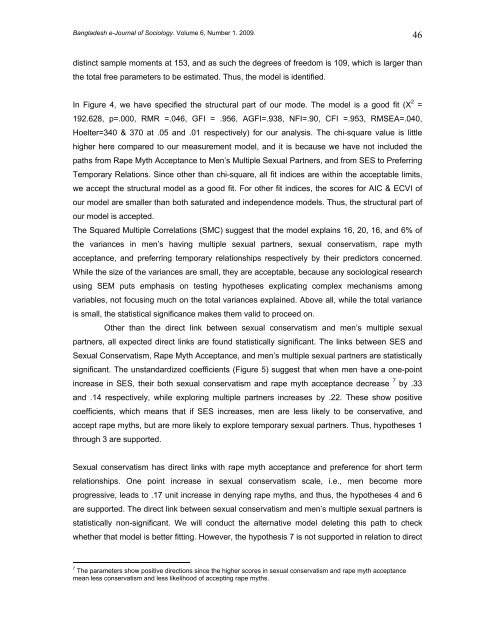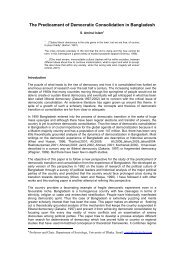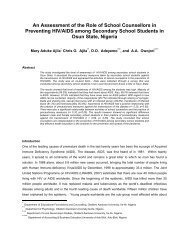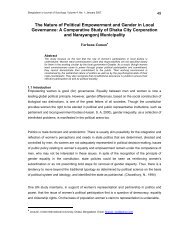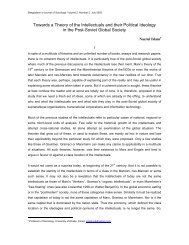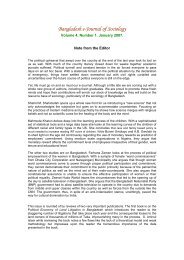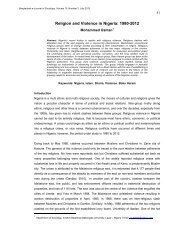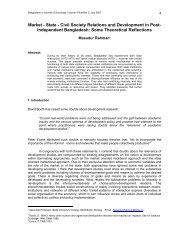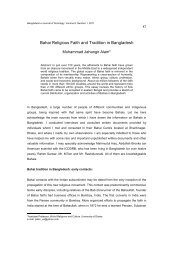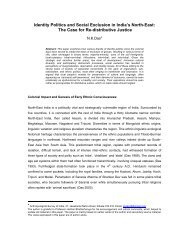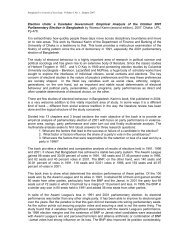Bangladesh e-Journal of Sociology - Bangladeshsociology.org
Bangladesh e-Journal of Sociology - Bangladeshsociology.org
Bangladesh e-Journal of Sociology - Bangladeshsociology.org
Create successful ePaper yourself
Turn your PDF publications into a flip-book with our unique Google optimized e-Paper software.
<strong>Bangladesh</strong> e-<strong>Journal</strong> <strong>of</strong> <strong>Sociology</strong>. Volume 6, Number 1. 2009.<br />
46<br />
distinct sample moments at 153, and as such the degrees <strong>of</strong> freedom is 109, which is larger than<br />
the total free parameters to be estimated. Thus, the model is identified.<br />
In Figure 4, we have specified the structural part <strong>of</strong> our mode. The model is a good fit (X 2 =<br />
192.628, p=.000, RMR =.046, GFI = .956, AGFI=.938, NFI=.90, CFI =.953, RMSEA=.040,<br />
Hoelter=340 & 370 at .05 and .01 respectively) for our analysis. The chi-square value is little<br />
higher here compared to our measurement model, and it is because we have not included the<br />
paths from Rape Myth Acceptance to Men’s Multiple Sexual Partners, and from SES to Preferring<br />
Temporary Relations. Since other than chi-square, all fit indices are within the acceptable limits,<br />
we accept the structural model as a good fit. For other fit indices, the scores for AIC & ECVI <strong>of</strong><br />
our model are smaller than both saturated and independence models. Thus, the structural part <strong>of</strong><br />
our model is accepted.<br />
The Squared Multiple Correlations (SMC) suggest that the model explains 16, 20, 16, and 6% <strong>of</strong><br />
the variances in men’s having multiple sexual partners, sexual conservatism, rape myth<br />
acceptance, and preferring temporary relationships respectively by their predictors concerned.<br />
While the size <strong>of</strong> the variances are small, they are acceptable, because any sociological research<br />
using SEM puts emphasis on testing hypotheses explicating complex mechanisms among<br />
variables, not focusing much on the total variances explained. Above all, while the total variance<br />
is small, the statistical significance makes them valid to proceed on.<br />
Other than the direct link between sexual conservatism and men’s multiple sexual<br />
partners, all expected direct links are found statistically significant. The links between SES and<br />
Sexual Conservatism, Rape Myth Acceptance, and men’s multiple sexual partners are statistically<br />
significant. The unstandardized coefficients (Figure 5) suggest that when men have a one-point<br />
increase in SES, their both sexual conservatism and rape myth acceptance decrease 7 by .33<br />
and .14 respectively, while exploring multiple partners increases by .22. These show positive<br />
coefficients, which means that if SES increases, men are less likely to be conservative, and<br />
accept rape myths, but are more likely to explore temporary sexual partners. Thus, hypotheses 1<br />
through 3 are supported.<br />
Sexual conservatism has direct links with rape myth acceptance and preference for short term<br />
relationships. One point increase in sexual conservatism scale, i.e., men become more<br />
progressive, leads to .17 unit increase in denying rape myths, and thus, the hypotheses 4 and 6<br />
are supported. The direct link between sexual conservatism and men’s multiple sexual partners is<br />
statistically non-significant. We will conduct the alternative model deleting this path to check<br />
whether that model is better fitting. However, the hypothesis 7 is not supported in relation to direct<br />
7<br />
The parameters show positive directions since the higher scores in sexual conservatism and rape myth acceptance<br />
mean less conservatism and less likelihood <strong>of</strong> accepting rape myths.


